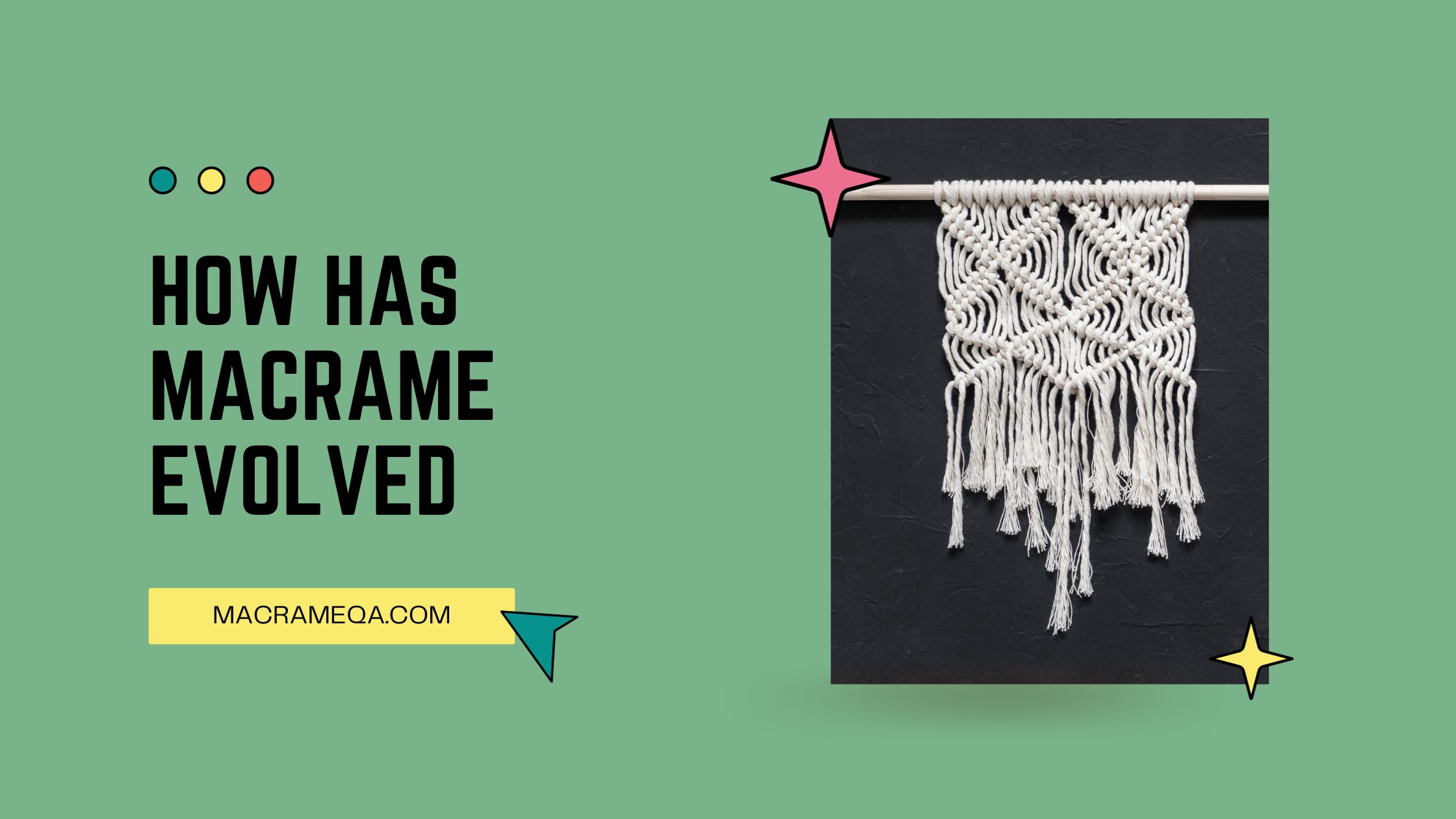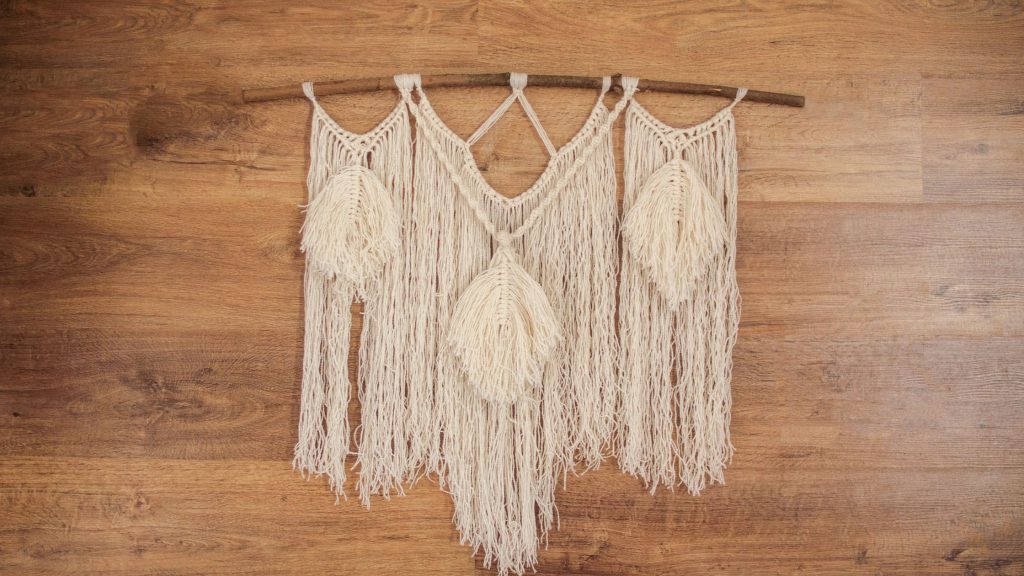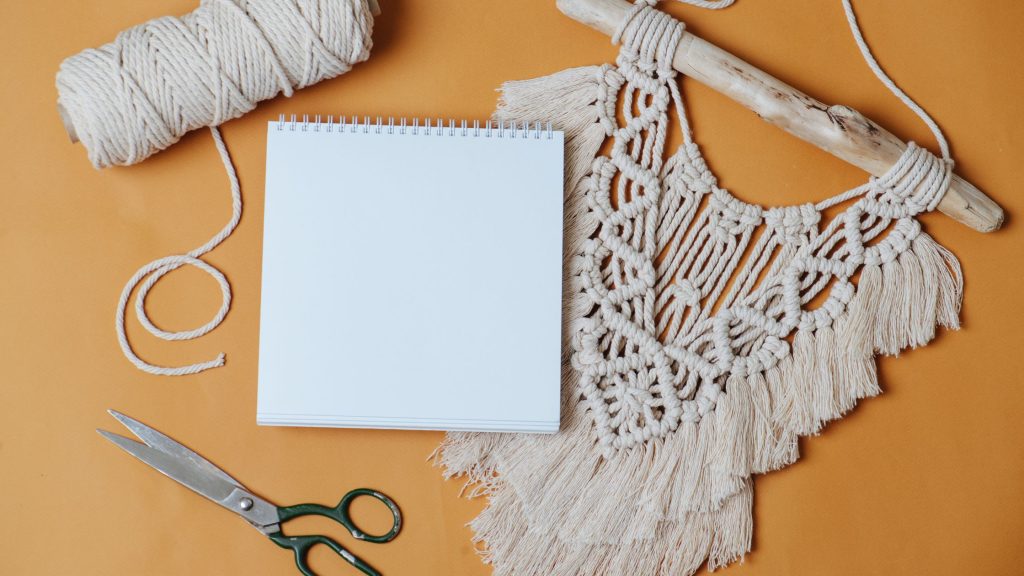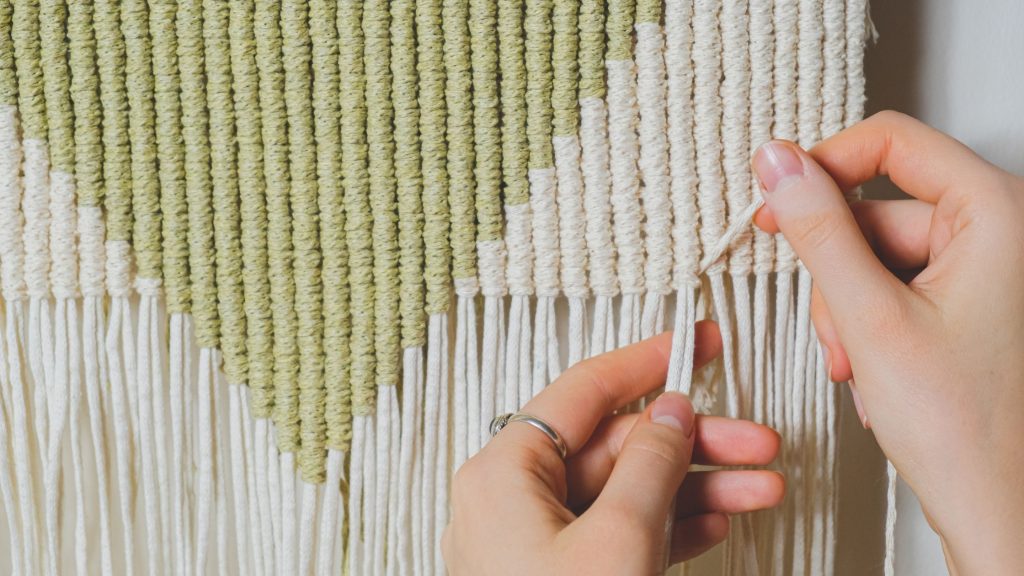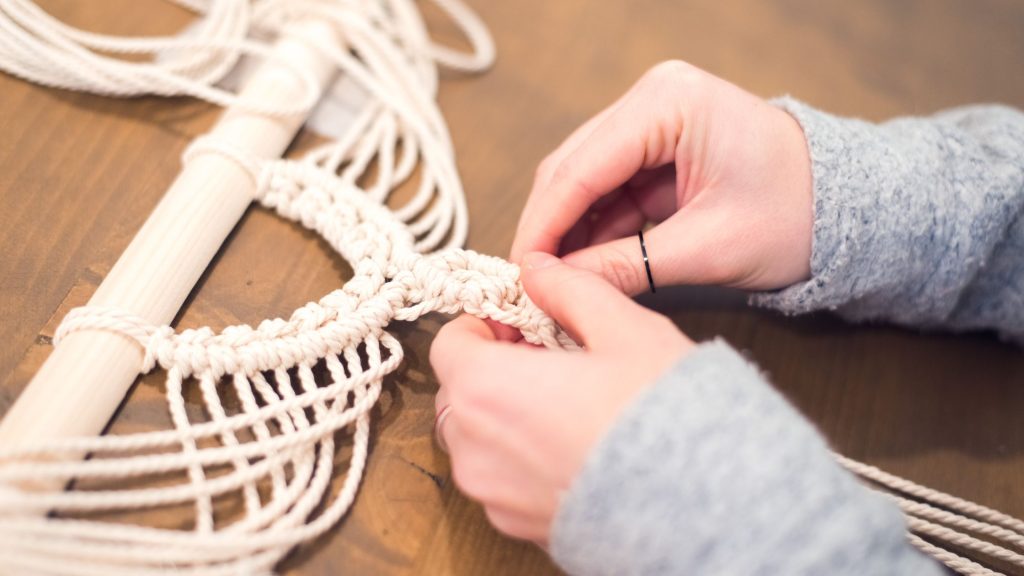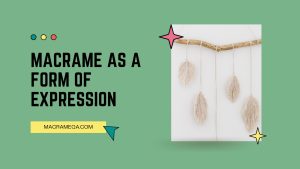Macrame, an ancient textile art form, has captured the hearts of people for centuries with its intricate knots and beautiful designs. From its origins in ancient Babylon to its modern revival in the 1970s, macrame has undergone a remarkable evolution. This article takes a closer look at the fascinating journey of macrame, exploring how it has transformed and adapted over the centuries, and how it continues to inspire and captivate craft enthusiasts today. So, sit back, relax, and prepare to be enchanted by the captivating history of macrame.
Ancient Origins of Macrame
Early Beginnings in Ancient Egypt
Macrame, the ancient art of knotting cords into intricate patterns, has a rich history that stretches back thousands of years. Its origins can be traced to Ancient Egypt, where evidence of macrame has been found in the form of wall decorations, tomb paintings, and even preserved textiles. The Egyptians used macrame to create decorative fringes on garments, as well as to embellish accessories such as belts and headdresses. These early macrame creations showcased the Egyptians’ advanced knotting techniques and their appreciation for intricate craftsmanship.
Spread to Ancient Persia
From Egypt, the art of macrame spread to Ancient Persia, known today as Iran. Persians embraced macrame and incorporated it into their textiles, home decor, and religious artifacts. The Persians were skilled weavers and added their unique twist to macrame by using delicate threads and incorporating intricate patterns and designs. Macrame was highly valued in Ancient Persia and was considered a symbol of wealth and prestige. The Persians further refined the techniques and knotting patterns, introducing new creative elements that would influence macrame styles for centuries to come.
Macrame in Ancient China
Ancient China also embraced macrame, recognizing its decorative and functional potential. Macrame was widely used in China for making garments, accessories, and household items such as curtains and beddings. The art form took on a distinct Chinese style, characterized by the use of silk threads and intricate knotting patterns. Macrame became an important part of Chinese culture, with various knot designs being imbued with symbolic meanings and used as charms for protection and good fortune.
Introduction to Europe by Moors
During the Middle Ages, macrame made its way to Europe through the Moors, who brought the art form with them during their occupation of Spain and Portugal. The Moors, renowned for their weaving and textile skills, introduced Europeans to the intricate knotting techniques of macrame. The art quickly gained popularity among European craftsmen, who incorporated macrame into their creations, including tapestries, lacework, and embroidery. Macrame became a symbol of luxury and sophistication, coveted by the noble classes throughout Europe.
Influence of Arab Weavers
Macrame’s influence continued to spread across Europe, thanks in part to the skilled Arab weavers who migrated to various European regions. These weavers brought with them their knowledge of macrame and introduced new knotting techniques and design elements to the art form. Macrame flourished in regions such as Spain, Italy, France, and England, where artisans made use of diverse techniques and patterns to create exquisite textiles, clothing, and decorative items.
Macrame in the Renaissance
Rise in Popularity in Europe
The Renaissance period marked a significant rise in macrame’s popularity in Europe. The revival of classical arts and crafts during this era provided fertile ground for macrame to thrive. Macrame creations became highly sought after among the noble classes and wealthy merchants, who commissioned intricate macrame pieces as a display of their wealth and social status. The intricate knotting techniques and detailed designs of macrame captured the imagination of artists and craftsmen, leading to a surge in creative macrame works.
Macrame in Royal Courts
Macrame became particularly prevalent in the royal courts of Europe during the Renaissance. Kings, queens, and nobles adorned their palaces with macrame tapestries, curtains, and decorative hangings. These elaborate macrame pieces were often used to commemorate special occasions, such as royal weddings and coronations. The macrame creations showcased the skill and craftsmanship of royal artisans, who spared no effort in creating intricate designs that reflected the grandeur and opulence of the era.
Distinct Styles and Techniques
The Renaissance saw the emergence of distinct macrame styles and techniques across Europe. Different regions developed their unique approaches to macrame, incorporating local influences and materials into their creations. Italian macrame, for example, was characterized by intricate lace-like patterns and delicate threads. French macrame, on the other hand, focused on bold designs and the use of luxurious materials such as silk and velvet. These regional variations added to the diversity and richness of macrame as an art form, allowing artists and craftsmen to explore new creative possibilities.
Macrame as a Status Symbol
During the Renaissance, macrame became more than just a decorative art form – it became a status symbol. Owning and displaying macrame creations became a way for the elite to showcase their wealth and artistic taste. Elaborate macrame hangings, clothing embellishments, and accessories were prized possessions and were often passed down through generations as treasured heirlooms. Macrame became a tangible representation of social standing and was coveted by those who could afford to commission or purchase these intricate works of art.
Decline in Macrame’s Popularity
Despite its immense popularity during the Renaissance, macrame saw a decline in its prominence in the following centuries. Changing artistic trends and the emergence of new crafts and technologies led to a shift in focus away from macrame. The Industrial Revolution and the mass production of textiles diminished the demand for handmade macrame creations. Macrame became associated with a bygone era, often considered outdated and overly decorative.
Revival of Macrame in the 19th Century
Inclusion in Victorian Home Decor
The 19th century marked a significant revival of interest in macrame, particularly in the realm of home decor. Macrame found a place in Victorian interiors, adding a touch of elegance and decorative flair to homes. Macrame hangings, curtains, and lampshades became popular choices for adorning parlors and dining rooms. The delicate knotting patterns and intricate designs of macrame complemented the ornate furnishings and opulent aesthetic of the Victorian era.
Macrame as a Decorative Art Form
With the revival of macrame, artists, and craftsmen began to explore new possibilities for the art form. Macrame transitioned from a purely functional craft to a decorative art form in its own right. Intricate macrame panels and wall hangings became highly sought after as statement pieces in homes and public spaces. The revival of macrame as a decorative art form paved the way for innovative designs and experimentation with new materials and techniques.
Macrame in Fashion and Jewelry
The 19th century also witnessed the incorporation of macrame into the world of fashion and jewelry. Designers and artisans recognized the versatility of macrame and its ability to create unique and intricate textures. Macrame lace became a popular choice for adorning garments, adding an element of sophistication and intricacy to dresses, collars, and accessories. Macrame techniques were also employed in the creation of jewelry, with delicate knotting patterns forming the basis for intricate necklaces, bracelets, and earrings.
Influence on the Arts and Crafts Movement
The Arts and Crafts movement, which emerged in the late 19th century, played a significant role in the revival of macrame. The movement, led by artisans and designers who sought to bring back traditional craftsmanship and celebrate the beauty of handmade objects, embraced macrame as a valuable and expressive art form. Macrame became integrated into the philosophy of the Arts and Crafts movement, with artists using natural materials and traditional techniques to create macrame pieces that embodied the movement’s ideals.
Macrame in Public Displays
As macrame gained popularity in the 19th century, it was increasingly showcased in public displays and exhibitions. International exhibitions and world fairs provided platforms for artists and craftsmen to showcase their macrame creations to a wider audience. These exhibitions helped to propel Macrame into the public eye, generating interest and appreciation for the art form. Macrame was recognized not only for its decorative value but also for its artistic merit and technical skill.
Macrame in the 20th Century
Macrame in the Arts and Crafts Revival
The 20th century witnessed a renewed interest in traditional crafts, including macrame, as a response to industrialization and mass production. The Arts and Crafts revival movement of the early 20th century sought to revive traditional craftsmanship and the beauty of handmade objects. Macrame, with its rich history and intricate techniques, became a prominent feature of this revival. Artists and craftsmen used macrame to create unique and expressive pieces that celebrated the beauty of handcrafted art.
Macrame as a DIY Trend
In the mid-20th century, macrame experienced a surge in popularity as a do-it-yourself (DIY) trend. Craft enthusiasts embraced macrame as a creative outlet, using readily available materials and instructional books to learn the art form. Macrame plant hangers, wall hangings, and accessories adorned homes, showcasing the individuality and creativity of the DIY movement. Macrame workshops and classes became increasingly popular, providing opportunities for people to learn and practice macrame techniques.
Influence of the Hippie Movement
The countercultural movement of the 1960s and 1970s, often referred to as the Hippie Movement, had a significant influence on the popularity of macrame. Macrame aligned with the movement’s ideals of self-expression, individuality, and a return to nature. Macrame wall hangings, jewelry, and clothing became synonymous with the bohemian lifestyle and were embraced by those seeking to break away from mainstream fashion and societal norms. Macrame became an emblem of the free-spirited and unconventional nature of the Hippie Movement.
Macrame in Interior Design
Throughout the 20th century, macrame remained a popular choice for interior design. Macrame wall hangings, curtains, and room dividers added texture and visual interest to homes and public spaces. The versatility of macrame allowed for a wide range of styles and designs. From minimalist and sleek to eclectic and bohemian, macrame could be tailored to suit different interior design aesthetics. Macrame continued to be valued not only for its decorative qualities but also for its ability to create a warm and inviting atmosphere.
Incorporation of Macrame in Fashion
In the latter half of the 20th century, macrame made its mark in the world of fashion once again. Designers recognized the appeal of macrame and incorporated it into their collections, creating unique and eye-catching garments. Macrame dresses, tops, and accessories graced runways, showcasing the versatility and artistry of the knotting technique. Macrame’s ability to create both intricate and bold designs made it a favorite choice for those seeking to make a fashion statement.
Contemporary Macrame Innovations
Modern Macrame Artists and Designers
In recent years, macrame has experienced a resurgence of interest, thanks to a new generation of talented artists and designers. These contemporary macrame artists push the boundaries of the craft, experimenting with new materials, techniques, and styles. Through their innovative and creative approach, they have elevated macrame to a new level of artistic expression. Social media platforms and online communities have also provided a platform for these artists to showcase their work and connect with a wider audience.
Exploration of New Materials
Contemporary macrame artists have expanded the range of materials used in macrame. Traditional fibers such as cotton and linen are still widely used, but artists now explore the possibilities of incorporating unconventional materials. Rope, leather, wire, and even recycled materials are now being integrated into macrame creations, adding texture and visual interest. These new materials allow for greater experimentation and provide unique opportunities for artists to create macrame pieces that are both visually stunning and environmentally conscious.
Macrame in Sustainable Design
The renewed interest in sustainable and eco-friendly practices has influenced the world of macrame. Artists and designers are opting for organic and ethically sourced fibers, promoting sustainability and responsible consumption. Macrame creations are now seen as environmentally friendly alternatives to mass-produced decorations. By using natural materials and traditional techniques, contemporary macrame artists contribute to the preservation of craft traditions and the promotion of sustainable design practices.
Integration of Macrame in Modern Art
Macrame has also found its place in the world of modern art. Contemporary artists incorporate macrame techniques and concepts into their artwork, blurring the boundaries between traditional craft and contemporary art forms. Sculptures, installations, and mixed media pieces now feature macrame elements, allowing artists to explore new dimensions of creativity and self-expression. Macrame’s tactile and three-dimensional qualities add a unique and captivating element to modern art exhibitions.
Macrame in Bohemian and Minimalist Styles
Modern interior design trends, such as bohemian and minimalist styles, have embraced macrame as a way to add texture, warmth, and visual interest to spaces. Macrame wall hangings, plant hangers, and curtains complement the natural color palettes and organic materials often found in these styles. In bohemian interiors, macrame adds a whimsical and organic touch, while in minimalist spaces, macrame provides a focal point and adds visual depth to the overall design. Macrame’s versatility makes it well-suited to various interior design aesthetics.
Macrame Techniques and Styles
Basic Macrame Knots
Cords or threads are the building blocks of macrame, and mastering basic macrame knots is essential for creating intricate designs. The most common macrame knots include the square knot, the half-hitch knot, and the double half-hitch knot. These knots are used to create the foundation of macrame patterns and can be combined in various ways to form more complex designs.
Variations of Knots
Macrame offers endless possibilities for creativity by varying the types and combinations of knots used. By altering the number of cords, the direction of the knots, and the spacing between them, artists can create a wide range of textures and patterns. Some popular variations include the spiral knot, the diagonal half hitch, and the lark’s head knot. These variations allow artists to experiment with different effects and create unique designs that reflect their artistic style.
Different Macrame Styles
Over the centuries, various macrame styles and techniques have emerged, each with its own distinct characteristics and aesthetic. Some popular macrame styles include lace macrame, which focuses on creating delicate and intricate lace-like patterns, and micro macrame, which utilizes fine cords to create intricate jewelry and accessories. Other styles include Victorian macrame, Bohemian macrame, and modern macrame, each offering its own unique appeal and creative possibilities.
Macrame in Wall Hangings
One of the most iconic uses of macrame is in the creation of wall hangings. Macrame wall hangings range from simple and understated designs to large and elaborate tapestries. Artists can incorporate various knotting techniques, patterns, and textures to create visually striking and captivating pieces. Macrame wall hangings have become a popular choice for adding a touch of bohemian or minimalist style to homes or public spaces.
Macrame in Plant Hangers
Macrame plant hangers offer a stylish and functional way to showcase indoor plants. Macrame plant hangers can be simple and elegant, using basic knots to support the plant pot, or they can be elaborate with intricate patterns and designs. The versatility of macrame allows for customization to fit different plant sizes and styles. Macrame plant hangers have become an integral part of the resurgence of indoor gardening and the desire to bring the beauty of nature into homes.
Cultural Significance of Macrame
Macrame in Indigenous Cultures
Macrame has deep cultural significance in many indigenous communities around the world. Indigenous peoples have used macrame for generations in their traditional crafts, incorporating local materials and knotting techniques to create symbolic and meaningful works of art. Macrame is often intertwined with religious, spiritual, and cultural practices, with specific knots and patterns holding spiritual significance and acting as protective symbols. The preservation and celebration of macrame traditions in indigenous cultures play a vital role in maintaining cultural heritage and fostering a sense of identity.
Symbolism in Macrame Designs
Macrame designs often carry symbolic meanings, especially in indigenous cultures and traditional practices. Knots and patterns can represent fertility, protection, love, and unity, among other qualities. Each culture has its own unique symbolism attached to specific macrame designs, allowing these creations to communicate deeper meanings beyond their aesthetic appeal. By understanding the symbolism behind macrame designs, individuals can gain a deeper appreciation for the craft’s cultural significance and the stories it tells.
Macrame as Cultural Artistry
Macrame is more than just a decorative craft – it is a form of cultural artistry. Traditional macrame techniques and styles are passed down through generations, connecting individuals to their cultural heritage. Macrame becomes a medium through which cultural stories, values, and traditions are woven into tangible creations. By engaging with macrame as a cultural art form, individuals can celebrate diversity, foster cultural understanding, and contribute to the preservation of cultural traditions.
Macrame in Rituals and Ceremonies
In many cultures, macrame plays a significant role in rituals and ceremonies. From weddings to religious ceremonies, macrame creates ceremonial garments, decorations, and accessories that hold spiritual and cultural meaning. Macrame creations are often believed to bring blessings and protection, with specific designs and patterns used to signify important stages in life or to honor divine beings. The incorporation of macrame in rituals and ceremonies emphasizes its cultural importance and its ability to create a connection between the physical and the spiritual realms.
Preservation of Macrame Traditions
In a rapidly changing world, the preservation of macrame traditions has become crucial. Organizations and individuals passionate about cultural preservation work to document and safeguard traditional macrame techniques, patterns, and styles. The passing down of knowledge and skills through workshops, apprenticeships, and educational initiatives helps to ensure that these cultural practices continue to thrive. By actively preserving macrame traditions, communities can maintain a sense of identity, promote cultural diversity, and celebrate the beauty of this ancient craft.
Macrame as a Therapeutic Craft
Meditative Qualities of Macrame
Macrame has long been recognized for its meditative qualities. The rhythmic and repetitive knotting process can induce a state of mindfulness and relaxation. As the hands move through the motions of tying knots, the mind becomes focused and thoughts are anchored to the present moment. The tactile nature of macrame provides a sensory experience that can alleviate stress, calm the mind, and promote a sense of peace. Many individuals find comfort in the process of macrame and use it as a form of meditation and introspection.
Stress Relief and Mindfulness
Engaging in macrame can provide a much-needed break from the stresses of everyday life. The act of knotting and creating something with one’s hands can be a therapeutic and soothing experience. The process of macrame allows individuals to immerse themselves in a creative flow, momentarily disconnecting from external pressures and worries. As the focus shifts to the present moment, stress levels decrease and a sense of calm and mindfulness is cultivated.
Macrame as a Form of Self-Expression
Macrame offers a unique avenue for self-expression. Through the choice of knots, colors, materials, and designs, individuals can infuse their personality and aesthetic into their macrame creations. Each macrame piece becomes a reflection of the artist’s unique style and creative vision. The process of creating something by hand can also be empowering, allowing individuals to express their emotions, desires, and individuality. Macrame becomes a tangible form of personal expression and a way to share one’s unique voice with the world.
Artistic Therapy and Well-being
For many individuals, macrame serves as a form of artistic therapy and contributes to overall well-being. Engaging in creative activities, such as macrame, has been shown to reduce anxiety, improve mood, and enhance overall mental health. The satisfaction of completing a macrame project, coupled with the sense of accomplishment, can boost self-esteem and generate a positive mindset. Macrame can serve as a refuge from daily stressors, providing individuals with a creative outlet and a means of self-care.
Macrame Workshops and Classes
The therapeutic benefits of macrame have led to the rise of macrame workshops and classes. These gatherings provide opportunities for individuals to learn macrame techniques, connect with like-minded individuals, and experience the therapeutic aspects of the craft in a supportive environment. Macrame workshops allow participants to delve into the creative process, ask questions, and receive guidance from experienced instructors. These interactive sessions foster a sense of community and provide a platform for individuals to nurture their well-being through art.
Macrame’s Influence on Other Crafts
Macrame in Weaving and Textiles
Macrame has had a profound influence on other textile-related crafts, particularly weaving. Macrame techniques and knotting patterns have been incorporated into woven textiles, creating intricate and visually stunning designs. Weavers often combine macrame elements with traditional weaving techniques, producing hybrid creations that showcase the versatility and aesthetics of both crafts. Macrame-inspired weavings and textiles have added a new dimension to the world of fiber art and have expanded the creative possibilities for textile artisans.
Incorporation of Macrame in Knitting and Crochet
Macrame is not limited to its craft but has permeated other fiber arts, such as knitting and crochet. Knitters and crocheters have shed traditional constraints and embraced macrame-inspired techniques to create unique and textured designs. Macrame-inspired stitches and patterns have become popular among fiber artists, allowing for the creation of statement garments, accessories, and home decor items. The integration of macrame techniques into knitting and crochet has breathed new life into these traditional crafts and brought a fresh and contemporary appeal.
Macrame in Mixed Media Art
Macrame’s emphasis on texture and its three-dimensional qualities make it a perfect fit for mixed media art. Artists have incorporated macrame elements into paintings, sculptures, and collages to add depth and tactile interest. Macrame panels and hangings can serve as a backdrop for mixed media compositions. In contrast, macrame knots and fibers can be integrated into the artwork itself, blurring the lines between different artistic disciplines. Macrame’s versatility in mixed media art allows artists to experiment and create visually captivating and conceptually rich creations.
Influence on Modern Fiber Art
Macrame has played a significant role in shaping the world of modern fiber art. Artists working in the field of fiber art have drawn inspiration from macrame techniques and styles, incorporating them into their creations. The exploration of knotting, braiding, and weaving techniques has expanded the boundaries of fiber art, allowing for the creation of intricate and innovative works. Macrame has become an integral part of the contemporary fiber art movement, enriching the field with its history, skill, and aesthetic possibilities.
Macrame in Contemporary Craft Projects
Macrame’s resurgence in popularity has led to its incorporation into a wide range of contemporary craft projects. DIY enthusiasts and crafters have adopted macrame as a versatile and accessible craft, using it to create home decor items, accessories, and gifts. Macrame plant hangers, wall hangings, and keychains have become popular choices for those looking to personalize their living spaces or create meaningful handmade gifts. The integration of macrame into contemporary craft projects has breathed new life into the craft and has broadened its appeal to a new generation of makers.
Future Trends in Macrame
Innovative Macrame Applications
As macrame continues to evolve, there is room for innovative applications of the craft. Artists and designers are constantly pushing the boundaries of traditional macrame, exploring new techniques and materials to create groundbreaking macrame creations. Innovations in lighting fixtures, furniture, and architectural features incorporating macrame are already emerging, offering new and unexpected ways to incorporate this ancient craft into contemporary spaces.
Sustainable and Eco-Friendly Macrame
Given the increased focus on sustainability and environmental consciousness, the future of macrame is likely to align with these values. There will be a greater emphasis on using environmentally friendly and ethically sourced materials in macrame creations. Artists and designers will continue to promote sustainable practices, ensuring that Macrame’s resurgence is rooted in responsible consumption and production. Macrame artists will explore natural dyes, organic fibers, and recycled materials, seeking to reduce their environmental impact and contribute to a more sustainable future.
Exploration of Digital Macrame
With advancements in technology, there is the potential for macrame to be explored in digital realms. Computer-generated macrame designs and simulations can allow artists to experiment with complex patterns and structures before creating physical pieces. Digital platforms may also provide interactive experiences where individuals can learn macrame techniques virtually and connect with a global community of macrame enthusiasts. While digital macrame cannot replace the tactile experience of working with physical materials, it opens doors to exciting possibilities and collaborations.
Collaborations with Other Industries
The future of macrame may involve collaborations with other industries, such as fashion, interior design, and sustainable architecture. Macrame techniques and styles can be incorporated into fashion collections, adding dimension and texture to garments and accessories. Interior designers may collaborate with macrame artists to create site-specific installations and customized macrame pieces for commercial and residential spaces. Sustainable architects may explore macrame as a sustainable building material, utilizing its tactile and visual qualities to create unique and environmentally friendly structures.
Continued Revitalization of Macrame
The revival of macrame shows no signs of slowing down. As individuals seek ways to reconnect with traditional crafts and express their creativity, macrame will continue to captivate and inspire. The accessibility of macrame, combined with its therapeutic benefits and aesthetic appeal, ensures that it will remain a popular choice among makers and enthusiasts. With each new generation embracing macrame and pushing its boundaries, the craft will continue to evolve and adapt to contemporary tastes, ensuring its continued presence in the artistic and creative landscape.

